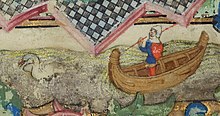Book of hours of Johann without fear
The book of hours by Johann ohne Furcht , Duke of Burgundy was for a ruler who, despite his intense preoccupation with politics and intrigue, found the time and desire to promote music, the arts and books. His most beautiful handwriting was the breviary (in the British Library ) created for him and his wife, Margarete von Bayern , which he carried with him when he died. This, his book of hours, is a relatively modest copy that contains the usual elements and gives the same importance to Parisian and Flemish saints in the calendar. In the intercessory prayers there are unusually long invocations of St. Leonhard included. The presence of St. Leonhard can indicate that the owner was imprisoned at some point. After the defeat of the French crusaders in Nikopol in Hungary in 1397, John of Burgundy (then Count of Nevers ) was captured by the Sultan Bajazed together with his comrades Guy de la Trémoille and Marshal Jean de Boucicaut . Johann's nickname goes back to his boldness during this horrific crusade . All three comrades in arms got away with their lives by paying a large ransom .
description
- Liturgy of Rome . Flanders , probably Ghent , 1406–1415. 13.8 × 20.1 cm, 252ff.
- 12 calendar illustrations, 28 large miniatures with rectangular ivy and acanthus leaf - borders .
- Bibliothèque nationale , Paris , ms. lat. nouv. acq. 3055
A small shield of the Burgundian coat of arms below the feet of St. Andreas, in the picture above, refers to Johann without fear as the owner of this book of hours. Andrew was the patron saint of Burgundy, and he is depicted here surrounded by Burgundian emblems . Carpenter's planes and trowels to the right and left of the saint (here nailed to the cross and not, as is usual, tied) seem to be unusual emblems for a prince if one does not know the circumstances under which they were recorded.
During the period of bitter rivalry between the Dukes of Orléans and Burgundy for influence over King Charles VI. and with it on the rule of France , Ludwig von Orléans had chosen a knotty stick and the motto "Je l´Enuie" - "I challenge you" as an emblem to challenge . John of Burgundy replied with the planer threatening to cut the knots off the Orléans stick and the trowel to humiliate and ruin his rival , and the Flemish motto: "I houd - I stand up".
At that time, personal identifiers and motto were given great importance, even if we consider this to be childish today. John of Burgundy was so proud of the trowel that he embroidered it on his robes and gave small silver and gold models together with golden wood shavings to his courtiers and servants , a truly precious gift. The background of the Andreas miniature is covered with the same motif .
The second miniature contains a very different kind of personal reference: The Whitsun scene is framed by a narrow, empty frame, which perhaps on purpose was not also filled in with the spiral pattern with small suns as in the Andreas miniature. In this way, the light ground at the foot of the page behind the armed knight standing in a boat pulled by a swan can act as a sky. What is Lohengrin , Parzival's son, doing in a book of hours? Where is his bride, Elsa von Brabant? The answer lies in Johann's own fearless family.

In October 1406 his daughter married Marie Adolph II. De la Marck, Count of Kleve . The rulers of Kleve relied on a descent from the legendary knight of the swan from the knight sagas, the Lohengrin. Since Marie was only twelve years old at the time of her marriage to a man of about thirty who had just become a widower , Lohengrin's appearance in her father's prayer book may not have been merely a gesture of courtesy towards her future husband, it was intended to be so to please a little girl. Due to difficulties with the dowry , Marie stayed at the court of Burgundy until 1415 and her wedding was postponed for a long time. By interpreting the picture as Lohengrin, the manuscript can be dated to shortly after 1406, perhaps even 1415–1416, when Johann finally gave his daughter to the Count of Kleve without fear.
Executive artist
The two miniatures come from a workshop in Ghent or Malines that created a series of books of hours described by Dorothy Miner: ... all characterized by lush and powerful foliage ornamentation , amusing drolleries and a skilled, decorative style of painting that is still predominant is gothic .
Individual evidence
- ^ Fanny Bury Palliser: Historic Devices, Badges, and War-Cries. sn, London 1870, p. 35.
- ↑ Jules de Chestret de Haneffe: Histoire de la Maison de la Marck y compris les Cléves de la seconde race . D. Cormaux, Lüttich 1898, p. 43 ( Société des Bibliophiles Liégeois. Publications in-quarto No 4).
- ^ Dorothy Miner: Illuminated Books of the Middle Ages and Renaissance. Trustees of the Walters Art Museum, Baltimore 1949, No. 125, p. 47 (exhibition catalog, Baltimore, Walters Art Museum , January 27 - March 13, 1949).
literature
- The book of hours by Johann ohne Feart, Duke of Burgundy. In: John Harthan: Books of hours and their owners. German translation by Regine Klett. Herder, Freiburg (Breisgau) et al. 1977, ISBN 3-451-17907-5 , pp. 98-101.


